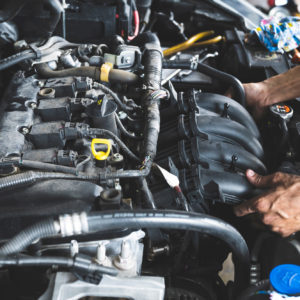What is a PTC heater in a car? Positive temperature coefficient (PTC) heaters help the vehicle’s heating, ventilation, and air conditioning (HVAC) system heat the air inside the cabin. Most HVAC systems direct hot coolant from the engine into a heat exchanger or heater core. Air passes through this heat exchanger and is directed into the cabin. However, hooking up a heat exchanger to an electric vehicle (EV) isn’t possible since it doesn’t have an engine with abundant heat. Instead, PTC heaters are used as they provide a safe, powerful, and energy-efficient way to produce heat for a vehicle’s cabin. Aside from EV’s, hybrid vehicles can also use PTC heaters when their engine isn’t turned on. PTC heaters can also be used to heat seats, vehicle mirrors, and steering wheels. They can also help heat EV batteries, cameras, and sensors.
How Do PTC Heaters Work?
PTC heaters use advanced ceramic discs to create heat when an electric current passes through the PTC heating element. Regular heaters can overheat if they receive too much current. PTC ceramic heaters have an advantage because they’re self-regulating. This means PTC heaters are able to prevent overheating by restricting current from passing through the PTC heating element when the material becomes hot. The ceramic material will only allow current to pass through if it’s at a specific temperature, which is typically around -40°F and 158°F.

Are PTC Heaters Better?
Using PTC heaters is better than relying on a vehicle’s heater core because PTC heaters can heat up quickly. PTC heaters also require less power to heat up. This means you don’t have to wait for the engine to heat up before the cabin gets warm. This can be a great relief during chilly winter days when you desperately need to get warm.
Traditional heating elements simply turn on and heat up to extremely high temperatures, leaving hot spots and uneven temperatures throughout the device. An extremely hot heating element might result in better heating, but it has some downsides. First of all, the heating element can melt or set fire to nearby components. Conventional heating elements also don’t always deliver the right amount of heat in the appropriate locations because of this uneven heating. High temperatures can also cause excessive wear on the heating element.
PTC heaters are safer than traditional coil heaters since they self-regulate. This means they don’t need controls or safety devices like fuses, sensors, or controls, which can fail over time. PTC heaters also distribute heat uniformity and have a lower maximum temperature, which can heat the cabin more efficiently and lead to a longer lifespan. This is why PTC heaters are considered to be more durable.
PTC heaters are also smaller and lighter, so they don’t occupy a lot of space inside a vehicle’s engine compartment. Overall, PTC heaters are innovative pieces of technology that can offer a lot of benefits over traditional heaters.
Any information provided on this Website is for informational purposes only and is not intended to replace consultation with a professional mechanic. The accuracy and timeliness of the information may change from the time of publication.






























